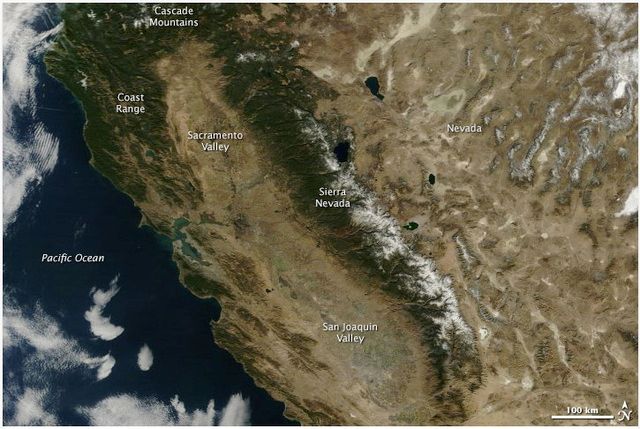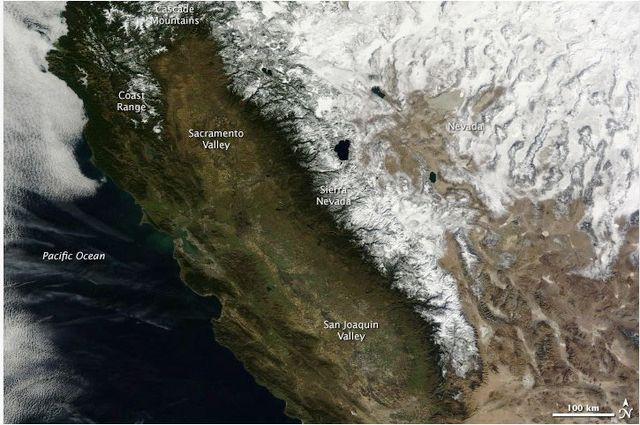General Discussion
Related: Editorials & Other Articles, Issue Forums, Alliance Forums, Region ForumsTwo Images Tell the Tale of California’s Terrifying Drought
Last edited Sat Feb 1, 2014, 07:50 PM - Edit history (2)
http://billmoyers.com/2014/01/31/two-images-tell-the-tale-of-californias-terrifying-drought/January 31, 2014
California is experiencing an epic drought. Paul Rogers reports for the San Jose Mercury News that some communities could actually run out of water in the next few months if the Golden State doesn’t get some rain:
In some communities, wells are running dry. In others, reservoirs are nearly empty. Some have long-running problems that predate the drought.
The water systems, all in rural areas, serve from 39 to 11,000 residents. They range from the tiny Lompico County Water District in Santa Cruz County to districts that serve the cities of Healdsburg and Cloverdale in Sonoma County.
And it could get a lot worse.
“As the drought goes on, there will be more that probably show up on the list,” said Dave Mazzera, acting drinking-water division chief for the state Department of Public Health.
California accounts for almost 12 percent of the nation’s agricultural production. As the PBS NewsHour put it, the dry spell “could mean bad news at the grocery store.”
---
At i09, Annalee Newitz offers two satellite images that show how dry it is. The first was taken a few days ago. The second shows the same territory last year. Newitz writes, “Note the radically different snow cover, and how the valley areas are a barren brown instead of a deep green.”
[URL=
 .html][IMG]
.html][IMG] [/IMG][/URL]
[/IMG][/URL]
[URL=
 .html][IMG]
.html][IMG] [/IMG][/URL]
[/IMG][/URL]SunSeeker
(51,571 posts)We're fucked.
![]()
MindMover
(5,016 posts)onethatcares
(16,172 posts)here in Tampa Bay.
Most expensive type of water recovery ever.
Problems that go on and on and on. Green Asian mussels are one.
If that's going to happen, someone is going to have to pay some big tax dollars to build the
refinery and keep it running.
Journeyman
(15,036 posts)The need for massive amounts of energy to drive it, the ravages to oceanic life and the coastal impact from the intake, the seemingly intractable problem of saline disposal, and the ever-present issue of funding for construction and maintenance (witness the near-criminal response the plant at Huntington Beach, California has generated, what with the proposed requirement that participating water districts must pay for their full allotment of water no matter whether they need it or not in any given year).
The Pacific Institute has an informative report on the topic:
Desalination, With a Grain of Salt: A California Perspective
available for free download from the Institute's website:
http://pacinst.org/publication/desalination-with-a-grain-of-salt-a-california-perspective-2/
The potential benefits of ocean desalination are great, but the economic, cultural, and environmental costs of wide commercialization remain high. In many parts of the world, alternatives can provide the same freshwater benefits of ocean desalination at far lower economic and environmental costs. These alternatives include treating low-quality local water sources, encouraging regional water transfers, improving conservation and efficiency, accelerating wastewater recycling and reuse, and implementing smart land-use planning.
while UC Berkley hosted the author of the report, Heather Cooley, which the University posted to YouTube as part of its "California Colloquium on Water":
MrMickeysMom
(20,453 posts)The best way to think about this solution is that you could either pay now or pay later… But, it's already "later"...
Hell Hath No Fury
(16,327 posts)The Carlsbad desalination plant is costing one billion to get online and will only provide 10% of San Diego county's current water needs. And the resulting fresh water is not going to be cheap.
MindMover
(5,016 posts)LeftyMom
(49,212 posts)a fair share of our power mix is hydro.
MindMover
(5,016 posts)and the sooner you get started the better for everyone ...![]()
LeftyMom
(49,212 posts)we do have a fuck of a lot of hydro and we're probably always going to have a fuck of a lot of hydro because we need it for flood control and water storage and all the other stuff you need when a big chunk of your population and essentially all of your farm land sits in a normally soggy valley at the base of a normally rather snowy mountain range.
Why am I explaining this to somebody who says "Cali" which is something only people who are twelve and/or from Nebraska say?
MindMover
(5,016 posts)Last edited Tue Feb 4, 2014, 01:10 PM - Edit history (1)
and mainly other states, rivers and mountains, and you no longer can rely upon any of the weather patterns that brought that moisture ... and I really do not need to tell you why you cannot rely on weather patterns anymore ...however, you still can rely upon the sun shining and the wind blowing ... and you have plenty of desert to place those panels or whatever ...
Your state name is tooooooooo long and since I still have an abode in Mendocino county, I will spell California; Cali, NoCal, SoCal and really any other way I want to spell it .... so stick that in your medical peace pipe and smoke it ....
bvar22
(39,909 posts)I'm afraid it is.
Peak Oil
&
Peak Water
spin
(17,493 posts)It's my bet it will end with a flood.
Two years ago my state of Florida was in the midst of a drought.
Tropical Storm Debby Floods Florida, Ends Drought
Published: June 26th, 2012, Last Updated: June 26th, 2012
Thanks in large part to Tropical Storm Debby, much of central and northern Florida has made a stunning turnaround from extreme drought conditions to severe flooding in a matter of days.
June is now on track to become one of the wettest such months in the state’s history, and numerous locations throughout the state are making a run at their record for the wettest June, if they haven’t surpassed it already.
***snip***
For example, as of June 25, Tarpon Springs had already received 21.04 inches of rain during June, eclipsing the record for the wettest June by nearly 3 inches. It has also been the wettest June in Tampa since records began there in 1890, according to the National Weather Service.
***snip***
For example, as of June 25, Tarpon Springs had already received 21.04 inches of rain during June, eclipsing the record for the wettest June by nearly 3 inches. It has also been the wettest June in Tampa since records began there in 1890, according to the National Weather Service.
http://www.climatecentral.org/blogs/thanks-to-tropical-storm-debby-florida-lurches-from-drought-to-flood
nomorenomore08
(13,324 posts)Gonna be a bumpy ride, to say the least...
spin
(17,493 posts)Several thousand years ago the Sahara Desert was lush and green. It may be green again due to global climate change.
Sahara Desert Greening Due to Climate Change?
James Owen
for National Geographic News
July 31, 2009
Desertification, drought, and despair—that's what global warming has in store for much of Africa. Or so we hear.
Emerging evidence is painting a very different scenario, one in which rising temperatures could benefit millions of Africans in the driest parts of the continent.
Scientists are now seeing signals that the Sahara desert and surrounding regions are greening due to increasing rainfall.
If sustained, these rains could revitalize drought-ravaged regions, reclaiming them for farming communities.
This desert-shrinking trend is supported by climate models, which predict a return to conditions that turned the Sahara into a lush savanna some 12,000 years ago.
http://news.nationalgeographic.com/news/2009/07/090731-green-sahara.html
Spider Jerusalem
(21,786 posts)It isn't just California. And palaeoclimatology and dendrochronology show that these drought events are both common and historically relatively frequent, and may last anywhere from decades to over a century. Combine that with climate change and these low-rainfall conditions could be a new normal. Which means the end of agriculture in places like the San Joaquin and Imperial Valleys, and the end of cities like San Diego and LA and Vegas. All of these rely on water from the Colorado River (which comes from Rocky Mountain snowmelt; climate change and global warming mean less snow, less snowmelt, more evaporation, and less water), and from snowmelt from the Sierra Nevadas (Sierra Nevada snowpack is at its lowest level ever).
jsr
(7,712 posts)Eleanors38
(18,318 posts)flamingdem
(39,313 posts)If so I'm surprised it's not getting more attention. That information should be used by urban planners to curtail water usage and new development.
Amazing images.